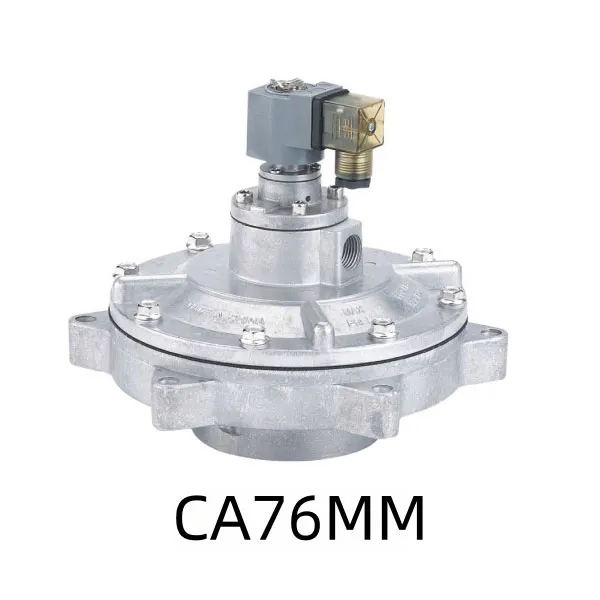Pulse Valves vs. Traditional Valves: Key Differences Explained
2024-12-10
Pulse valves and traditional valves are both essential components in pneumatic and fluid systems, but they serve different purposes and operate in distinct ways. While both types of valves control the flow of air or liquids, their designs and applications vary significantly, particularly in high-speed or specialized processes. Below, we’ll explore the key differences between pulse valves and traditional valves, highlighting their unique features and use cases.

1. Basic Functionality and Operation
Pulse Valves:
- Primary Function: Pulse valves are designed to provide quick, controlled bursts or "pulses" of air or gas. They are typically used in systems that require rapid, momentary releases of pressure, such as in dust collection, filtration, and cleaning systems.
- Operation: Pulse valves open and close very quickly, creating a sharp burst of air that is used to clean filters or move materials. They are usually activated by an electronic or pneumatic signal, which triggers the release of compressed air in a controlled pulse.
- Common Use: Pulse valves are most commonly found in dust collection systems, pneumatic conveying systems, paint spraying systems, and cleaning applications that require periodic bursts of air.
Traditional Valves:
- Primary Function: Traditional valves (such as ball valves, globe valves, and gate valves) are designed to regulate, stop, or allow the flow of air, liquid, or gas in a controlled and steady manner. They are more suited to continuous flow applications where constant regulation is needed.
- Operation: Traditional valves open or close gradually and maintain a steady flow of material, without the quick on/off bursts characteristic of pulse valves. These valves are generally operated manually or with actuators for automated flow control.
- Common Use: Traditional valves are used in a wide range of industries, including water systems, oil and gas pipelines, chemical processing, and HVAC systems, where constant or gradual flow control is required.
2. Speed and Response Time
- Rapid Response: Pulse valves are designed to operate quickly, with response times typically in the millisecond range. This is because they need to release bursts of air or fluid with high speed and precision, making them ideal for tasks that require intermittent, high-pressure air bursts.
- Quick Opening and Closing: The ability to open and close rapidly allows pulse valves to generate powerful pulses of air, which is critical for cleaning filters or moving materials in pneumatic systems.
Traditional Valves:
- Slower Response: Traditional valves generally have slower response times compared to pulse valves. This is because their operation is designed for gradual flow control, whether opening, closing, or throttling the flow.
- Gradual Adjustment: Traditional valves open and close slowly to allow for controlled, steady flow over an extended period, without the immediate release seen in pulse valves.
3. Design and Construction
Pulse Valves:
- Quick-Action Mechanism: Pulse valves have a quick-action diaphragm or piston mechanism that enables them to create rapid bursts. They typically feature a direct-acting design for fast response.
- Specialized Construction: Pulse valves often feature a high-flow capacity in a compact form and are designed to handle high-pressure air bursts. Their design is optimized to withstand the forces generated by quick air pulses without damage or leakage.
- Components: Pulse valves typically include solenoids, diaphragms, springs, and pressure regulators to control the timing and force of the pulse.
Traditional Valves:
- Variety of Designs: Traditional valves come in many types, such as ball valves, gate valves, globe valves, and check valves. Each type is designed to serve a specific function, such as opening and closing, regulating pressure, or maintaining flow direction.
- Continuous Flow Handling: Traditional valves generally have simpler constructions aimed at allowing continuous, non-interrupted flow. They are designed to handle liquids or gases at a steady, consistent pressure.
- Components: Components can include balls, discs, or gates that move against seals to regulate flow. Actuators, gears, and motors may also be used for automatic operation.
4. Application Areas
- Dust Collection Systems: Pulse valves are frequently used in industrial dust collectors to periodically clean the filter media by sending bursts of air to clear the accumulated dust.
- Pneumatic Conveying Systems: In material handling systems, pulse valves provide controlled bursts of air to keep materials flowing through the system.
- Automated Cleaning: Pulse valves are used in applications where automated, high-pressure bursts are required for cleaning purposes, such as in air blast cleaning systems or paint spraying systems.
- Process Control Systems: They are used in systems where quick adjustments to air pressure are necessary for specific processes (e.g., in packaging machinery or textile manufacturing).
Traditional Valves:
- Water and Gas Pipelines: Traditional valves are integral in regulating the flow of water, oil, gas, and other fluids in pipelines and industrial systems.
- Chemical Processing: Traditional valves are used to control the flow of chemicals, allowing for precise and gradual adjustments to pressure and flow rate.
- HVAC Systems: In heating, ventilation, and air conditioning (HVAC) systems, traditional valves help manage water or refrigerant flow in various components of the system.
- Industrial Automation: Traditional valves are also used in various types of manufacturing and processing lines where gradual flow regulation is necessary, such as in food and beverage production or pharmaceutical manufacturing.
5. Control and Precision
- High Precision for Intermittent Actions: Pulse valves are designed for systems requiring precise control of intermittent actions. For instance, the timing of the pulse is crucial in cleaning systems, where the exact moment and pressure of the air burst must be controlled.
- Electronic Control: Pulse valves are often activated via electronic or pneumatic signals, allowing them to be integrated into automated systems for precise timing and control of air or fluid pulses.
Traditional Valves:
- Continuous Flow Regulation: Traditional valves excel at regulating steady, continuous flow, with less precision required in terms of timing. The control is more about adjusting the volume or pressure gradually and consistently.
- Manual or Automated Control: Traditional valves can be controlled manually or automatically, with actuators providing fine adjustments for precise flow control.
6. Durability and Maintenance
Pulse Valves:
- Maintenance Needs: Pulse valves can experience wear due to the high-frequency opening and closing, which can result in a shorter lifespan compared to traditional valves. Regular maintenance is necessary to ensure the pulse mechanism remains effective.
- Specialized Parts: Because of the high-pressure and rapid operation, pulse valves may require specialized components like diaphragms or seals, which need to be inspected and replaced periodically.
Traditional Valves:
- Longer Lifespan for Steady Use: Traditional valves are generally more durable for continuous use and have fewer moving parts. They are built for long-term operation with less frequent maintenance.
- Standard Maintenance: Traditional valves are often easier to maintain, with many designs being robust enough to last for years without significant issues, especially in non-aggressive applications.
Conclusion: Pulse Valves vs. Traditional Valves
Both pulse valves and traditional valves serve unique purposes in fluid and gas systems. Pulse valves are best suited for applications requiring rapid bursts of air or fluid for cleaning, pressure relief, or material transport, and they are often used in specialized, high-speed applications like dust collection and pneumatic conveying. In contrast, traditional valves are ideal for controlling steady, continuous flow in a wide range of industries, from oil and gas pipelines to HVAC systems and chemical processing plants.
The key differences lie in their operational speed, flow control mechanisms, and application areas. While pulse valves excel in high-speed, intermittent actions, traditional valves are more suited for managing steady, continuous flows. Choosing the right valve depends on the specific needs of the system and the type of process being controlled.


